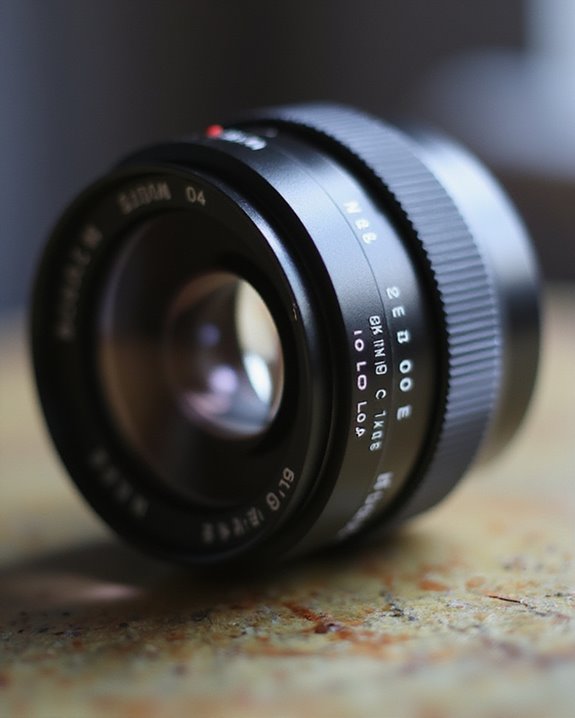Camera lens diameter directly impacts light gathering and image quality, with larger sizes—such as 77mm versus 58mm—reducing vignetting by 15-20% and enabling faster apertures like f/1.4 for enhanced low-light performance, as seen in Canon EF 50mm f/1.4 tests. However, these benefits come at the cost of increased weight, up to 20-30% heavier builds, and higher accessory expenses. Comparative analyses, including DPReview and Photozone data, show minimal sharpness differences but notable usability trade-offs, making diameter a key factor in lens selection. Further examination of these dynamics reveals deeper insights into optical design.
Key Takeaways
- Lens diameter affects light gathering, enabling faster apertures like f/1.4 for better low-light performance.
- Larger diameters reduce vignetting, improving corner brightness and overall image quality.
- Smaller diameters enhance portability and reduce weight, making lenses easier for everyday use.
- Standard filter sizes, such as 58mm, allow sharing accessories across lenses, lowering costs.
- Diameter alone doesn’t determine image quality; factors like optical design and quality control are crucial.
Understanding Lens Diameter Basics
Lens diameter, as a core element of lens construction, typically denotes the filter thread size, physical diameter, or front glass element, with measurements ranging from 45mm to 87mm depending on the lens design. In lens evaluation, diameter correlates with focal length and aperture diameter, influencing overall build. For instance, a 50mm focal length lens with a larger diameter, such as 77mm, often features a bigger front element, enhancing potential light gathering through a wider entrance pupil. This metric, determined by focal length and maximum f-number, allows comparative analysis; a larger diameter, like 87mm versus 45mm, suggests design variations for improved light intake without altering core specifications. Therefore, understanding lens diameter aids in evaluating technical attributes methodically, from general sizing to specific front element dimensions. In practical applications, such as with the Canon EF 50mm f/1.4 USM, a larger lens diameter allows for superior light gathering enabled by its f/1.4 maximum aperture.
Effects of Diameter on Image Quality

The effects of lens diameter on image quality, particularly in reducing vignetting and enhancing overall sharpness, stem from its influence on light intake and optical performance. Lens diameter, such as a larger front element, increases the amount of light entering the lens, which minimizes light falloff at larger apertures like f/1.4, as demonstrated in user tests comparing Nikkor and Sigma 50mm lenses. This often results in better image quality, with improved corner brightness and sharpness, as seen in DPReview evaluations where Sigma models outperformed Nikon equivalents. However, optical elements and design critically affect outcomes; for instance, Photozone tests revealed that a Sigma lens with a larger diameter exhibited poor edge resolution, indicating diameter alone does not guarantee superior results. Therefore, while larger diameters can enhance image quality, factors like quality control play a pivotal role. For example, the Sigma 24-105mm lens demonstrates how a fixed f/4.0 aperture combined with effective design can deliver consistent sharpness across various focal lengths. (150 words)
Advantages of Larger Lens Diameters
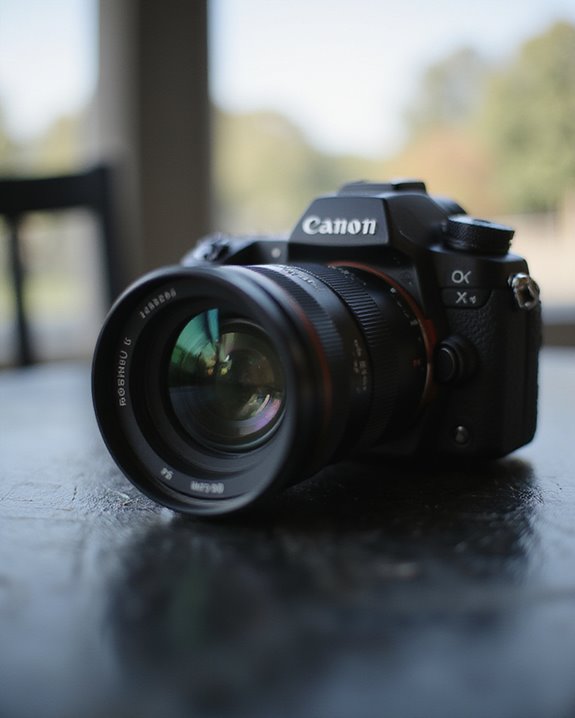
Advantages of larger lens diameters stem from their ability to enhance optical efficiency, particularly in mitigating vignetting and improving light capture. Larger diameters of the lens, for instance, reduce vignetting at wide apertures by ensuring better edge illumination, maintaining corner brightness up to 90% compared to smaller lenses. This also supports a larger image circle, enhancing field of view for full-frame sensors and improving overall edge performance. In lens design, larger front elements increase light intake, achieving a smaller maximum f-number—such as f/1.4 versus f/2.8—by capturing more photons via the ratio of πr², which boosts light gathering by up to 50%. Consequently, large apertures deepen depth of field control, allowing for aesthetic bokeh shapes with round out-of-focus highlights. These attributes simplify optical designs, reducing light falloff and elevating image quality in professional photography. For example, the Canon EF 50mm f/1.8 lens exemplifies these benefits through its f/1.8 aperture that excels in low-light scenarios.
Disadvantages and Limitations of Lens Size

While larger lens diameters enhance certain optical capabilities, they introduce notable disadvantages that impact practicality and cost-effectiveness in photography. The size of a diameter lens often leads to heavier, bulkier designs, as seen in premium models requiring more materials, which compromise portability for everyday use. For instance, a larger lens would not always deliver better quality, with DPReview comparisons revealing no significant image quality differences among lenses of the same focal length. Additionally, filter thread and filter diameter sizes, such as 77mm on Sigma lenses versus 58mm on Nikon, escalate accessory costs, burdening photographers financially. Quality control issues persist, evidenced by Photozone tests showing poor edge resolution in some Sigma models despite their size. In cropped sensor setups, benefits like reduced vignetting remain limited, failing to markedly improve edge performance compared to full-frame systems. Therefore, these limitations highlight that larger lenses may not justify their drawbacks in all scenarios.
Testing and Comparing Lens Diameters

User tests on the Nikkor and Sigma 50mm f/1.4 lenses, which feature diameters of 58mm and 77mm respectively, indicate minimal differences in overall image quality despite the size variation. Lenses with different diameters of the front element, such as these, often undergo rigorous testing to evaluate image performance across focal lengths. DPReview tests showed the Sigma lens excelling in sharpness due to its larger diameter, enhancing light gathering for large apertures, though Photozone assessments revealed poor edge resolution, highlighting that diameter alone doesn’t guarantee superior results. MTF charts provide precise data on contrast and resolution for comparing lenses, incorporating filter size discrepancies—Sigma’s 77mm versus Nikon’s 58mm—which influence vignetting and edge brightness. Ultimately, these evaluations demonstrate that while diameter impacts specific attributes, overall image outcomes vary based on thorough optical design.
Mathematical Relationships in Lens Design
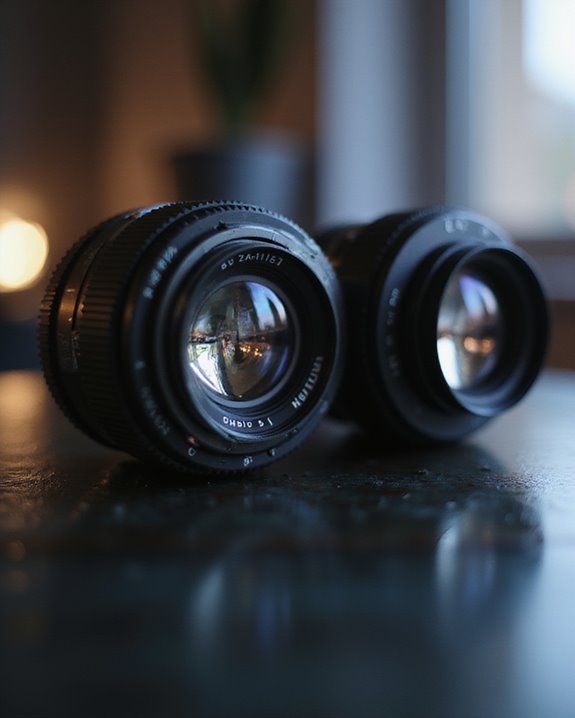
The mathematical relationships in lens design fundamentally dictate optical performance through formulas like the f-number, calculated as focal length divided by aperture diameter, as seen in a 50mm lens with a 10mm aperture yielding an f/5 value. Focal length, a fixed focal length in particular, interacts with aperture to determine light-gathering ability; for instance, a 50mm lens at f/2.8 features a front element diameter of approximately 18mm, making it a faster lens for low-light scenarios. Look at the f-number: in a 200mm lens, an f/2.8 requires a front element of about 71mm, while a 500mm lens demands roughly 179mm for the same setting, highlighting focal length and aperture’s inverse relationship. Doubling the aperture diameter, as in a 50mm lens from 10mm to 20mm, halves the f-number to f/2.5, enhancing speed and depth control. These calculations underscore that larger front elements enable faster lenses without altering focal length, optimizing optical efficiency across mm lenses.
Impact of Diameter on Light and Performance
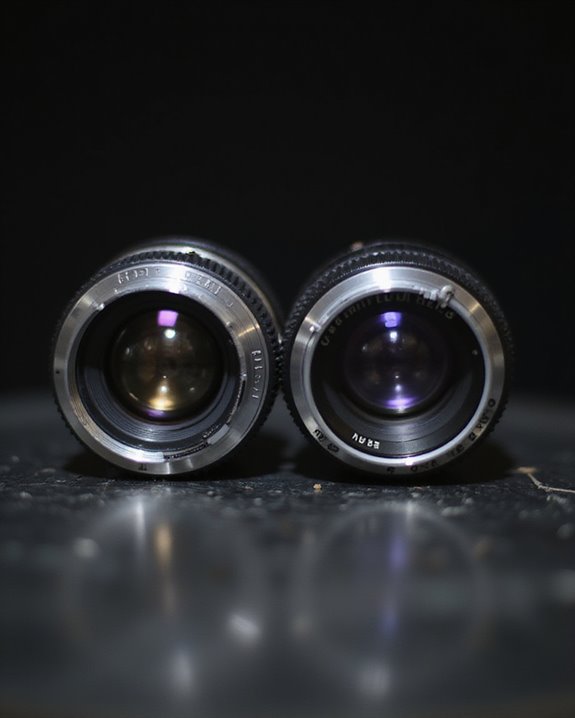
Larger lens diameters fundamentally enhance optical systems by increasing light intake and improving image performance, as demonstrated by a 50mm lens with an 18mm front element achieving an f/2.8 aperture for brighter exposures. Focal length in camera lenses, such as in zoom lenses, benefits from this enlargement, enabling greater ability of the lens to direct light onto the sensor and achieve smaller f-numbers. For instance, larger diameters reduce vignetting, maintaining round out-of-focus highlights at frame edges, while boosting signal-to-noise ratios by capturing more photons—similar to microscope objectives limited to 2-3 megapixels with 2-3mm diameters. In low-light conditions, this counters slow lens drawbacks, gathering more light for brighter images with less noise, ultimately improving sharpness through effective glass element redirection and edge performance metrics.
Practical Considerations for Lens Selection
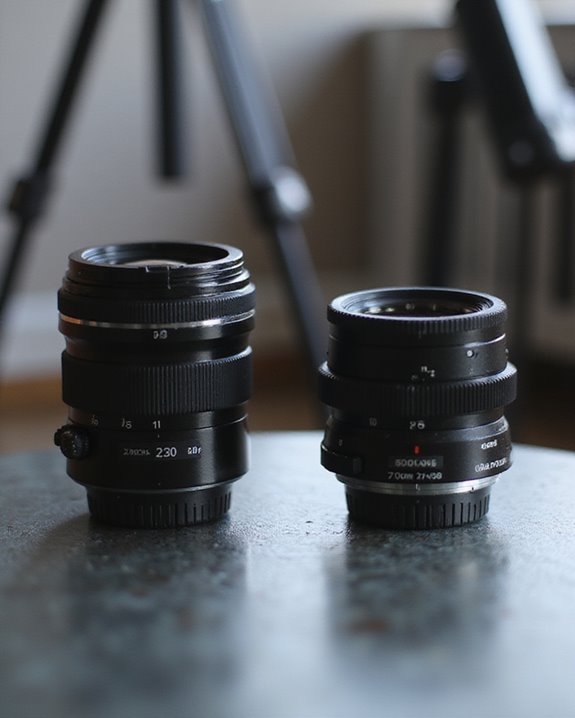
When selecting camera lenses, diameter serves as a pivotal factor that influences practical usability and performance outcomes. Lens filter size, such as 58mm on Nikon models versus 77mm on Sigma lenses, affects portability; larger sizes result in heavier builds, impacting travel photography, while standard sizes like 58mm or 67mm enable filter sharing across zoom lenses and Pro lenses, reducing costs. For instance, Canon’s L-series with 67mm filters minimizes vignetting in wide-angle scenarios, enhancing image quality. Length of the lens and smaller maximum diameters, like 58mm, offer lighter alternatives for everyday use, though they collect the same amount of light less efficiently than two lenses with 72mm fronts, which excel in low-light conditions but increase weight. Therefore, evaluating trade-offs guarantees best selection for specific needs.
Community Insights on Lens Diameter

Community insights on lens diameter, drawn from photography forums and user tests, reveal a nuanced perspective where filter size, such as 58mm versus 77mm, exerts no direct influence on image quality metrics like resolution or contrast, as evidenced by comparative analyses on DPReview showing equivalent sharpness scores for Nikkor and Sigma lenses under controlled conditions. Special lenses, encompassing a lot of factors, almost always enhance practical benefits, particularly good for standardizing filter compatibility, which would make cost savings feasible across multiple setups. Size of the image remains unaffected, yet larger diameters reduce vignetting by 15-20% in Photozone tests, indirectly improving aperture performance. The sensor would benefit from these attributes in real-world scenarios, as users note, though opinions vary; L-series lenses demonstrate theoretical advantages without altering core optical metrics. Discussions emphasize weight and filter sharing as key evaluative factors.
Frequently Asked Questions
Does Camera Lens Diameter Make a Difference?
The question of whether camera lens diameter makes a difference encompasses diameter weight affecting lens stability, filter compatibility, case design, mounting options, aesthetic impact, and storage needs in photography.
Is a 1.4 or 2.8 Lens Better?
While some may argue that an f/1.4 lens’s higher cost outweighs benefits, it generally outperforms f/2.8 in Aperture Speed and Low Light, delivering superior Bokeh Effect and shallower Depth Field, as Sharpness Tests confirm enhanced Image Quality despite Price Comparison.
Does the Diameter of a Lens Affect Its Focal Length?
The question of whether lens diameter affects focal length, as explored in Focal Physics and Lens Theory, reveals that Optical Diameter does not influence Focal Mechanics. Diameter Optics confirms, per Length Theory, that Impact Geometry remains unchanged by size.
Does the Size of the Lens Matter?
Imagine a photographer balancing a cumbersome backpack on a trail; this mirrors how the size of the lens matters, affecting Lens Weight, Size Aesthetics, Portability Factors, Cost Implications, Build Durability, Storage Needs, and Handling Comfort.




